
Importance of preparation

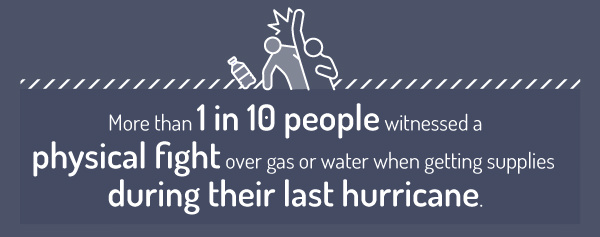 For residents living in coastal areas or high flood zones, there are many resources to help people prepare for the storm season. According to Ready.gov, the following precautions represent the first line of defense during a tropical storm or hurricane:
For residents living in coastal areas or high flood zones, there are many resources to help people prepare for the storm season. According to Ready.gov, the following precautions represent the first line of defense during a tropical storm or hurricane:
- Subscribe to your community’s weather warning system so that you’re fully briefed at all times on the trajectory and estimated arrival of a named storm.
- Become familiar with your evacuation zone and shelter locations.
- Protect your property, including decluttering drains and gutters to prevent backups in the event of flooding.
Within 36 hours of a storm making landfall, Ready.gov recommends the following preparations for any resident that may be impacted by intense weather:
- Restock your emergency preparedness kit, including water for at least three days, flashlights, batteries, first-aid supplies, and cash in case you’re unable to make purchases after the storm with credit or debit cards.
- Find alternative methods of communication if you lose power. This may include text messages or social media.
- Double-check that you’re 100 percent familiar with your evacuation zone and nearby shelters.
- Make sure you have sufficient gas in the event of a last-minute evacuation.
According to our survey, the more prepared people were for their last hurricane, the safer they felt during the storm. Compared to slightly over 29 percent of people who were underprepared or very underprepared and felt safe, 67 percent of prepared or very prepared respondents felt secure during the storm they experienced.
Seeking shelter
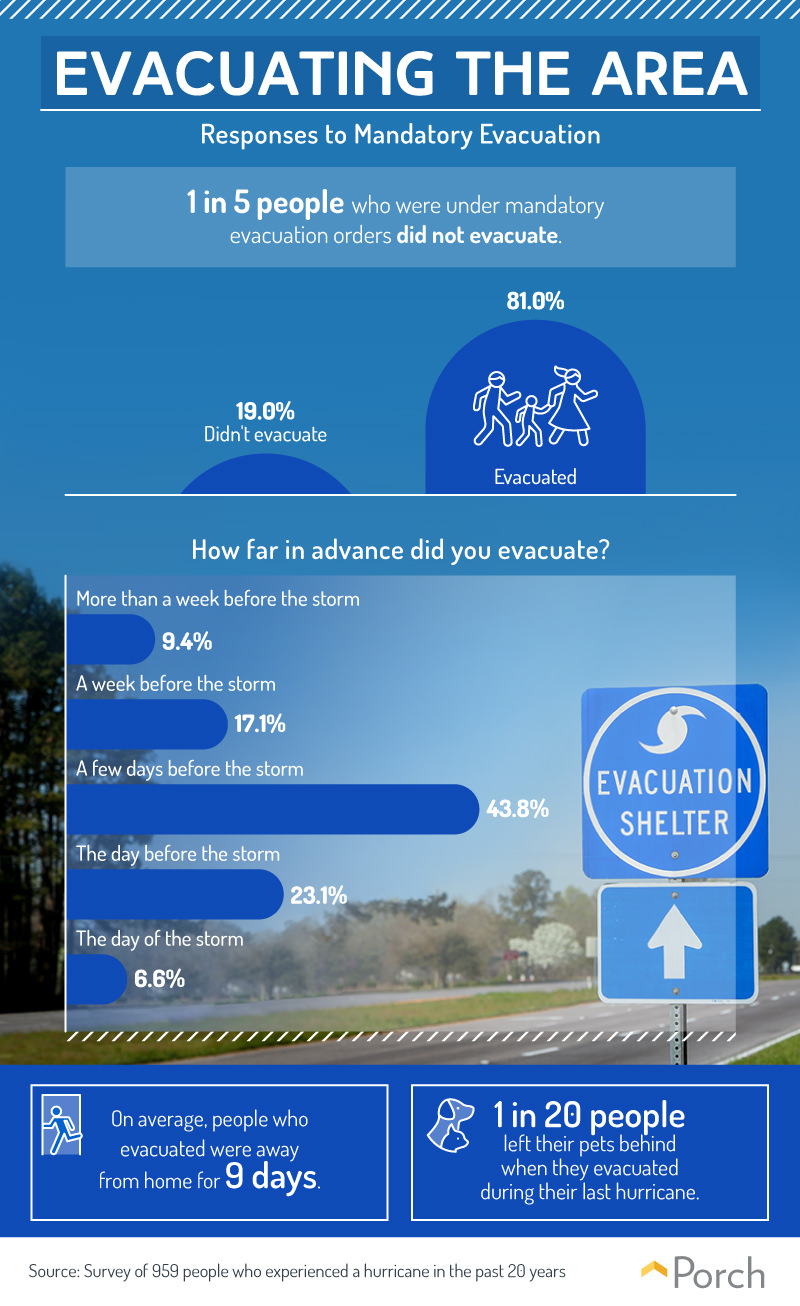
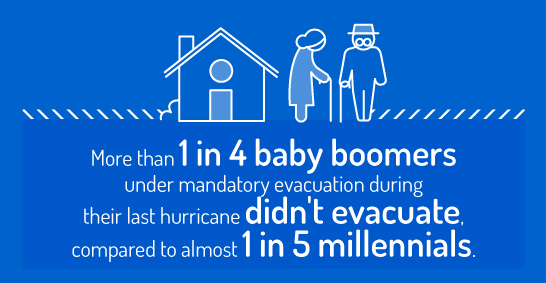 Deciding whether to evacuate during a storm can be complicated for some residents. With the proper precautions (including hurricane shutters or stormproof glass), your home may feel safe and protected from the elements. Still, experts warn that if your area is under mandatory evacuation, staying put could jeopardize your family’s health and safety. If you do decide to evacuate (or are ordered to do so), it’s recommended that you take only what you need, pack an emergency car kit, and turn off all of the gas and electricity in your home before leaving. Our study found that 1 in 5 people under mandatory evacuation admitted to staying home instead of taking shelter elsewhere. On average, people who evacuated were away for nine days, perhaps waiting for flood levels to subside or power to be restored in their area. Nearly 44 percent of respondents reported leaving just a few days before the storm, while 23 percent left just one day before landfall. One in 20 people also admitted to leaving a pet behind during hurricane evacuations. In 2019, a Florida bill was introduced that would consider the act of residents leaving their pets behind during a disaster as animal cruelty. During Hurricane Irma in 2017, 49 dogs and two cats were rescued by animal control officers before the storm.
Deciding whether to evacuate during a storm can be complicated for some residents. With the proper precautions (including hurricane shutters or stormproof glass), your home may feel safe and protected from the elements. Still, experts warn that if your area is under mandatory evacuation, staying put could jeopardize your family’s health and safety. If you do decide to evacuate (or are ordered to do so), it’s recommended that you take only what you need, pack an emergency car kit, and turn off all of the gas and electricity in your home before leaving. Our study found that 1 in 5 people under mandatory evacuation admitted to staying home instead of taking shelter elsewhere. On average, people who evacuated were away for nine days, perhaps waiting for flood levels to subside or power to be restored in their area. Nearly 44 percent of respondents reported leaving just a few days before the storm, while 23 percent left just one day before landfall. One in 20 people also admitted to leaving a pet behind during hurricane evacuations. In 2019, a Florida bill was introduced that would consider the act of residents leaving their pets behind during a disaster as animal cruelty. During Hurricane Irma in 2017, 49 dogs and two cats were rescued by animal control officers before the storm.
Community support
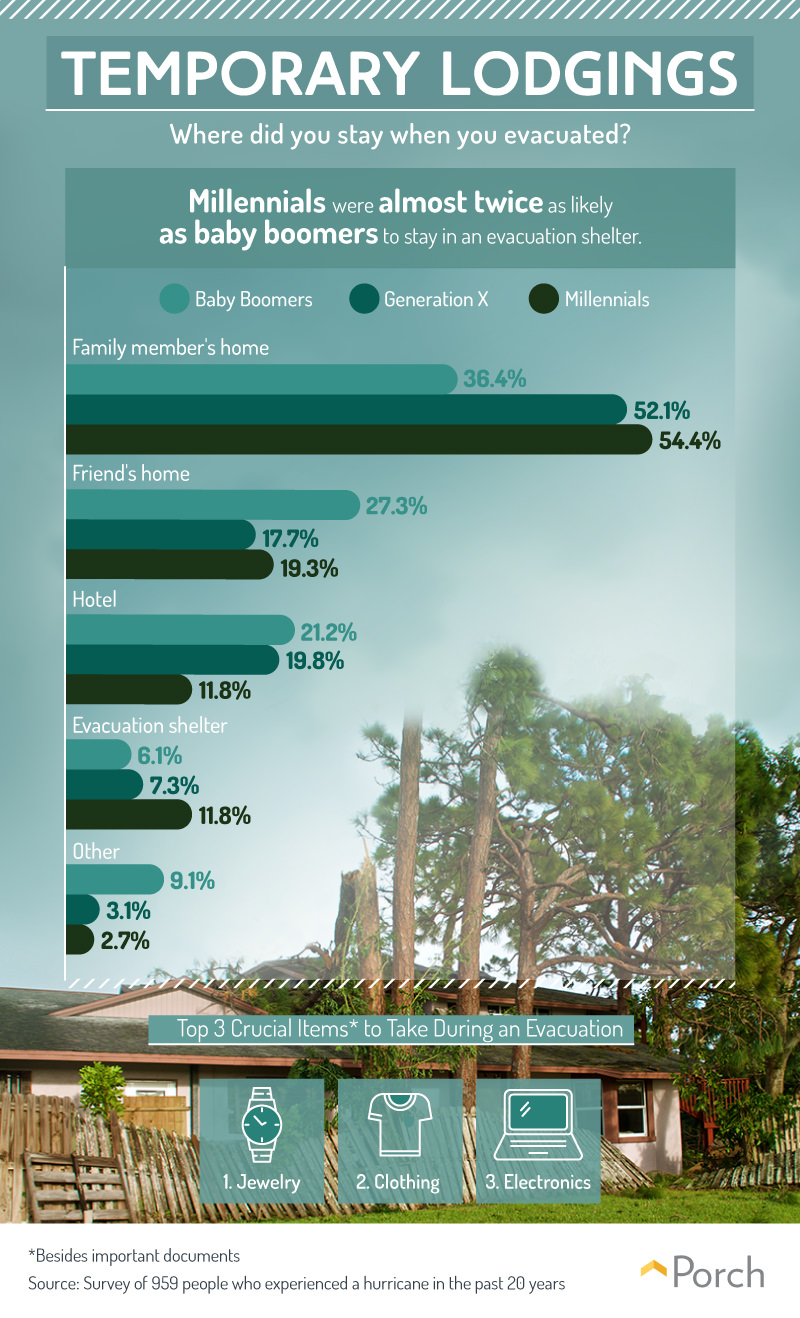
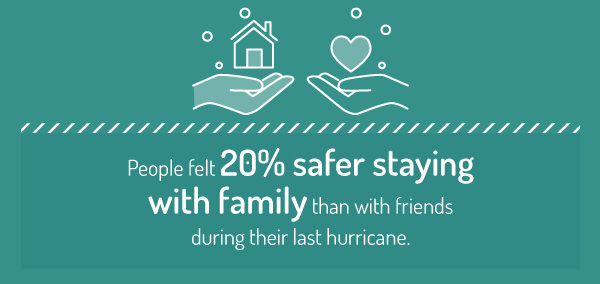 For people without means of transportation, making an early effort to evacuate for a hurricane can be a life-saving decision. Overwhelmingly, respondents stayed with family, including over 54 percent of millennials, 52 percent of Gen Xers, and more than 36 percent of baby boomers. Compared to the other generations, baby boomers were more inclined to stay with friends (27 percent) or at a hotel (21 percent). In contrast, nearly 12 percent of millennials stayed in an evacuation shelter, compared to just 6 percent of baby boomers and 7 percent of Gen Xers. Those evacuating often prioritized bringing jewelry, clothing, and electronics along when leaving their homes.
For people without means of transportation, making an early effort to evacuate for a hurricane can be a life-saving decision. Overwhelmingly, respondents stayed with family, including over 54 percent of millennials, 52 percent of Gen Xers, and more than 36 percent of baby boomers. Compared to the other generations, baby boomers were more inclined to stay with friends (27 percent) or at a hotel (21 percent). In contrast, nearly 12 percent of millennials stayed in an evacuation shelter, compared to just 6 percent of baby boomers and 7 percent of Gen Xers. Those evacuating often prioritized bringing jewelry, clothing, and electronics along when leaving their homes.
Necessary support
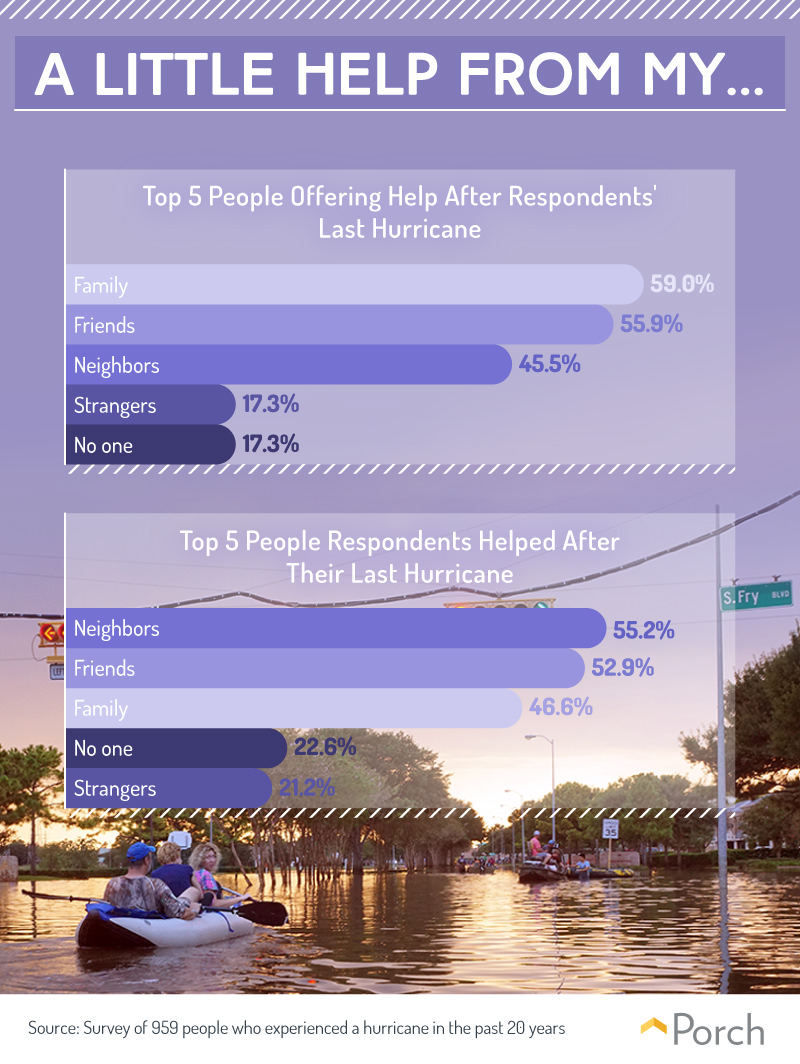
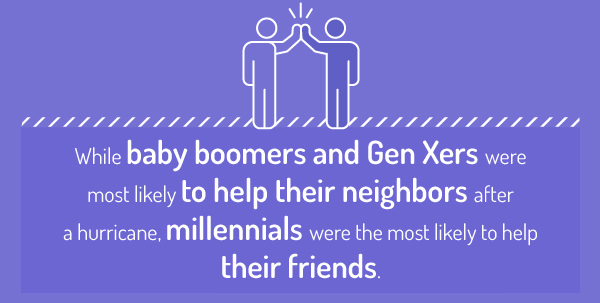 The immediate days and weeks after a hurricane can sometimes be just as dangerous as during the storm itself. It is recommended that residents return to their homes only once instructed by government officials and those who stayed behind to keep indoors until instructed otherwise. It’s equally as important that those affected by severe weather use personal electronics for emergencies only to conserve battery life, report hazards (included downed power lines), and to watch for roads or bridges that may have been weakened. More than half of people who experienced a hurricane received support after the storm from family (59 percent) and friends (almost 56 percent), while nearly 46 percent could rely on their neighbors. Just 17 percent of respondents didn’t receive any outside support following a hurricane. Similarly, more than half of respondents offered to help their neighbors (55 percent) and friends (53 percent).
The immediate days and weeks after a hurricane can sometimes be just as dangerous as during the storm itself. It is recommended that residents return to their homes only once instructed by government officials and those who stayed behind to keep indoors until instructed otherwise. It’s equally as important that those affected by severe weather use personal electronics for emergencies only to conserve battery life, report hazards (included downed power lines), and to watch for roads or bridges that may have been weakened. More than half of people who experienced a hurricane received support after the storm from family (59 percent) and friends (almost 56 percent), while nearly 46 percent could rely on their neighbors. Just 17 percent of respondents didn’t receive any outside support following a hurricane. Similarly, more than half of respondents offered to help their neighbors (55 percent) and friends (53 percent).
Firsthand experience
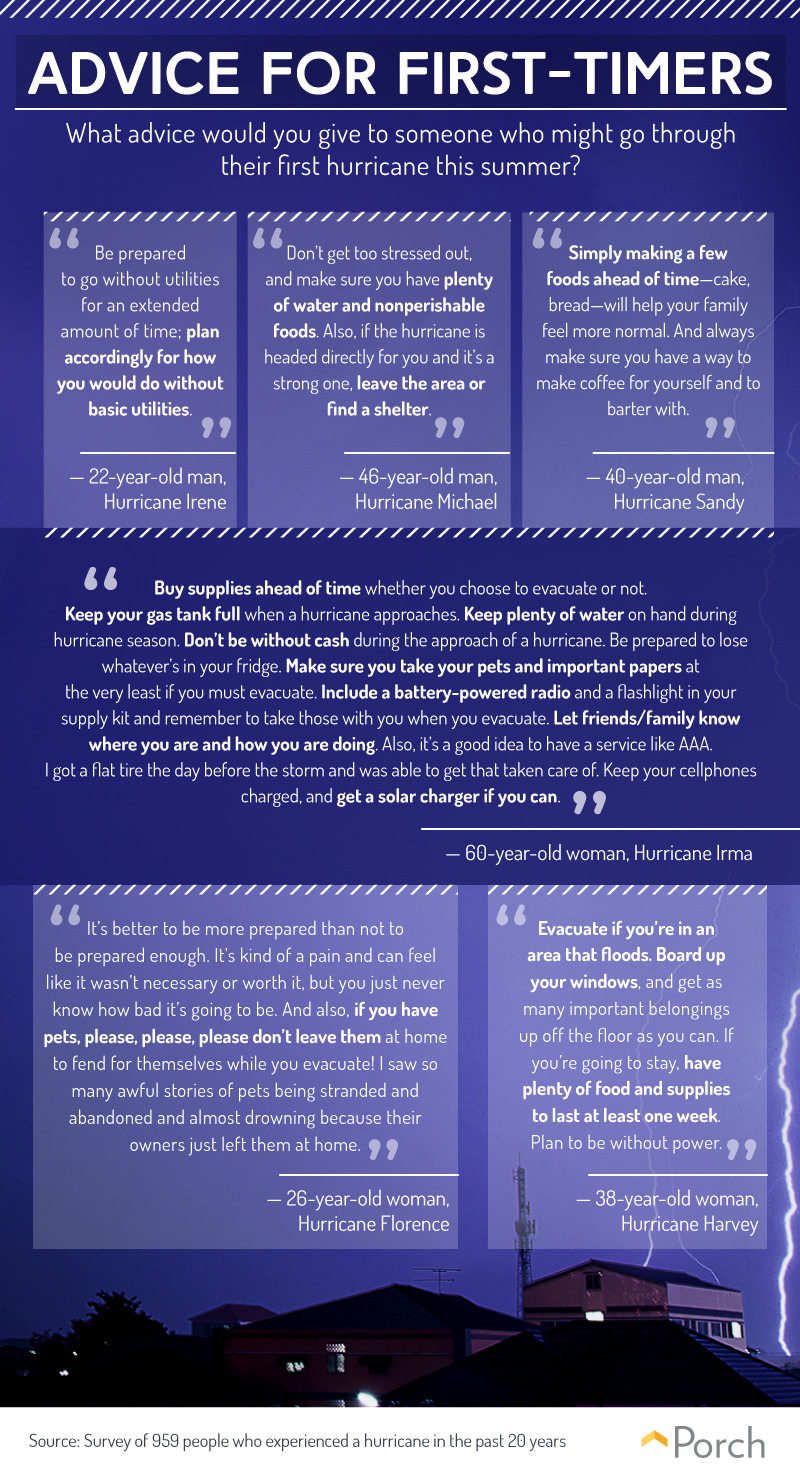 Preparing for a hurricane can be an overwhelming experience. Not knowing what to expect, how quickly a storm might gain strength or change trajectory, or what happens after the weather has passed can be frightening regardless of how many hurricanes you’ve lived through. Here, we compiled advice from over 950 people who experienced hurricanes for those who might endure one for the first time. As you can see from their responses, it is strongly advised to heed evacuation warnings, buy supplies in advance, ensure you have plenty of clean water, and know which resources will be available to you at every stage of the storm.
Preparing for a hurricane can be an overwhelming experience. Not knowing what to expect, how quickly a storm might gain strength or change trajectory, or what happens after the weather has passed can be frightening regardless of how many hurricanes you’ve lived through. Here, we compiled advice from over 950 people who experienced hurricanes for those who might endure one for the first time. As you can see from their responses, it is strongly advised to heed evacuation warnings, buy supplies in advance, ensure you have plenty of clean water, and know which resources will be available to you at every stage of the storm.
Weathering the storm
At almost every phase of a tropical storm or hurricane, residents in impacted areas are exposed to dangerous, and sometimes deadly, situations. Despite the increasing strength of hurricanes in recent years, people often felt safer during a storm when they were adequately prepared for it. As we found, many people evacuated and could count on the help of family, friends, and neighbors during their last hurricane. At Porch, we’re committed to making sure your home is hurricane-ready all year long. With our dedicated team of Porch Services pros and our extended Porch Pro Network, you can find certified professionals in your area for landscaping needs, window installation, structural engineering, and so much more. As the storm season approaches, we’ll help make sure your home is the last thing you need to worry about. Visit us online to put your next home improvement project in motion.
Sources
- https://www.cnn.com/2013/05/31/world/americas/hurricane-statistics-fast-facts/index.html
- https://www.theguardian.com/world/2019/may/20/are-hurricanes-getting-stronger-and-is-the-climate-crisis-to-blame
- https://www.accuweather.com/en/weather-news/5-of-the-deadliest-hurricane-dangers/70001646
- https://www.ready.gov/hurricanes
- https://www.cdc.gov/disasters/hurricanes/evacuate.html
- https://www.abc15.com/national/florida-bill-would-punish-owners-who-leave-pets-behind-during-hurricanes
- https://psmag.com/environment/who-didnt-evacuate-for-hurricane-katrina
- https://www.tripsavvy.com/staying-safe-during-hurricane-1513589
Methodology and limitations
To collect the data presented above, a survey was run that asked people who’d been through a hurricane in the last 20 years about their experiences during their most recent hurricane. Of these respondents, 77 were baby boomers, 243 were from Generation X, 613 were millennials, and 26 came from generations outside those. 442 of the respondents were men, 514 were women, and three chose to identify as neither. To qualify for this survey, respondents had to have experienced a hurricane in the past 20 years. All data seen in the study above rely on self-reporting, which can come with a host of issues (such as telescoping or exaggeration). To make sure that respondents paid attention as they took the survey, an attention check was used and disqualified anyone who did not pass it.
Fair use statement
Hurricanes can be a frightening and dangerous experience for many people. Help your readers prepare for the next storm by sharing our study for any noncommercial use with the inclusion of a link back to this page as credit for our contributors.
